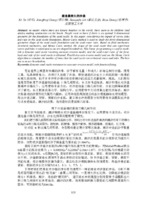| dc.description.abstract | No matter where there are leisure beaches in the world, there seem to be children (and adults) making sandcastles on the beach. People want to know if there is an optimal 3-dimensional geometry for the foundation of the sand castle. In this paper, considering the impact of waves, tides and rain on the sand castle foundation, Monte Carlo method is used to study the three-dimensional geometric shape of the sand castle foundation and the sand-water ratio. Based on fluid mechanics, structural mechanics, and Monte Carlo method, the shape of the sand castle that can experience
waves and tides is calculated as an arc-shaped hexahedron. Non-linear programming is used to establish a dynamic sand castle resisting seawater erosion model, and the sand-water ratio of the front, back and side of the sand castle is obtained. Establish a rain erosion model and use the Monte Carlo algorithm to simulate the number of times that the sand castle can withstand waves and tides. The best one is an arc hexahedron. | ru |

